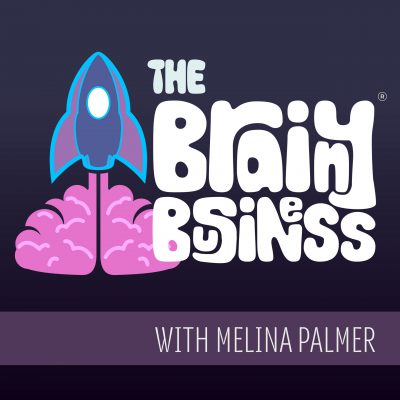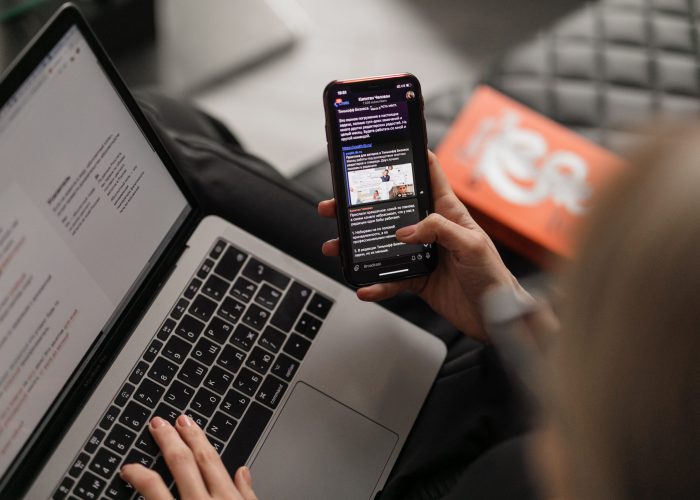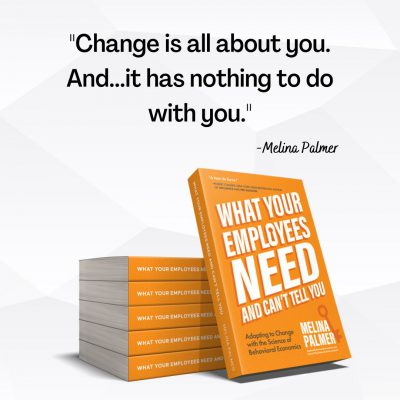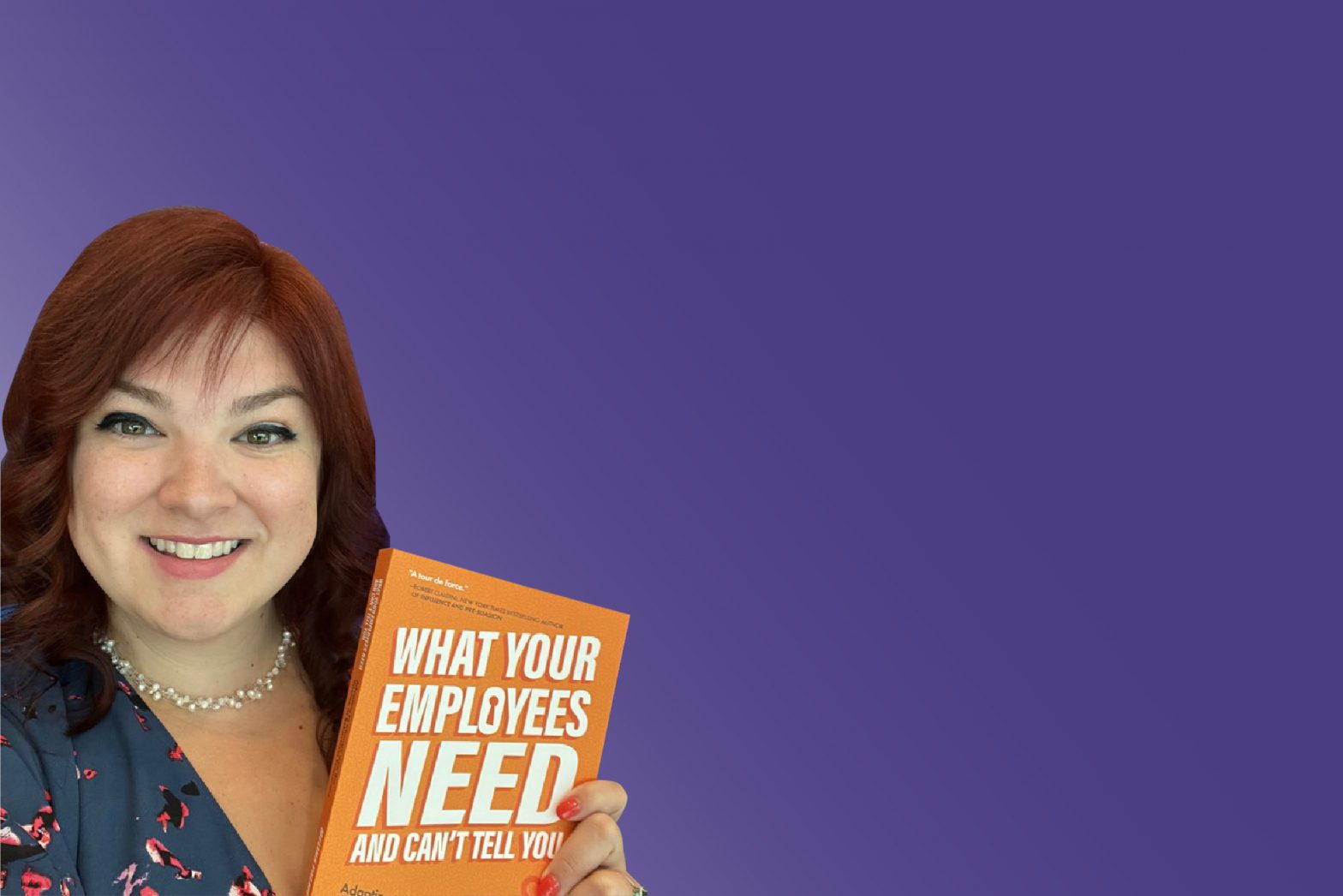An Interview with Melina Palmer
Melina Palmer is an applied behavioral economist and founder CEO of The Brainy Business. She consults with several global businesses on Behavioral interventions both on the consumer-facing as well as employee engagement issues. Melina also hosts an award-winning podcast called The Brainy Business podcast and which has more than half a million downloads across 170 countries around the world. She teaches Behavioral Economics at Texas A&M and has written two books – What Your Customers Want and Can’t Tell You and her latest, What Your Employees Need and Can’t Tell You. In this insight-packed interview with worxogo’s Saurabh Jain, Melina talks about biases, employee engagement, communication and miscommunication. Read to get insights and Behavior Science tips to help managers become more effective and help teams manage change better.
Saurabh: Can you elaborate on the kind of work you do with businesses, corporates. What are some of the problems they come to you with and how do you help them solve these issues?
Melina: As an applied behavioral economist, I help people to understand what people will actually do instead of what we think they should do. And how to communicate more effectively by understanding the psychology of why people act, choose, change and buy.
I do a lot of training in the corporate space. I help teams, managers either understand on the employees side – what people need, or on the consumer side – brand, pricing strategy, and how communication can be more efficient and effective.
Ideally I’m coming in as early as possible in a project because I ask a lot of open-ended questions that help determine that the organization is working on the right problem.
It’s really easy to find the right answer to the wrong question.
Too often, in business, we jump so fast into problem-solving mode that we’re working on the wrong thing. We’re making band-aids for bacterial infections.
Here’s an example of a sustainability project I did with Walmart on reducing plastic usage. Initially there had been a project where the plastic bags were made thinner but ended up being so thin that people started double-bagging. Then it became a bigger problem than what it was before. And so we worked through a process I call “question-storming” to help look at some other ways that we can view the problem in another light to be able to get to a new place.

Applications of Behavior Science at the Workplace
S: That’s a fascinating example of the Perverse Incentive/Cobra Effect. So, what kinds of organizations can Behavior Science be applied to?
M: Definitely, all businesses – all shapes, sizes can benefit from understanding and communicating better. In many ways, for a small business, it makes a much bigger impact. I have plenty of solopreneurs that listen to the Brainy Business podcast or get my books or are part of my classes at Texas A&M.
For instance solopreneurs struggle to sell an $8000-10000 package. After learning some tips on relativity, anchoring, and framing, they went on to have two people in a row pick $20000 packages. This, just by changing the way they talked about it.
S: Is there a renewal in interest in how organizations use Behavioral Science to make better business decisions?
M: Every day there are new people discovering Behavioral Science, Behavioral Economics and finding podcasts, books, interviews. It’s becoming more mainstream and allowing people to unlock new opportunities.
There was an academic era. People like me got our masters and thought, “Where’s all the applied stuff?” There were a lot of things in the non-profit and government space but then we started seeing more happening in corporate. Even then, it has been pretty heavily focussed on an advertising-marketing side of things.
My second book focuses on how behavioral science can be effective and helpful for things like employee engagement, employee interactions, teams and management training and HR. We’re seeing more happening there now, too.
Behavior Science: From Customer Experience to Employee Experience
S: So, about your books. First, What Your Customers Need and Don’t Tell You and now What Your Employees Need and Don’t Tell You. How have you applied Behavior Science to improve customer and employee experience? One example of each would help.
Customer Experience
M: So for a customer-facing piece I’ll share some work I did for a Financial institution. I ran a marketing department for a Financial Institution for 6 years. I know that banks and credit unions like their jargon, like many industries. Like APRs and APYs (Annual Percentage Rate or Annual Percentage Yield on money that you pay for a loan). These terms are thrown around as if they mean something to the average person when they really don’t.
The financial institution had a new checking account that rewards check in. They were really excited and wanted me to be part of the messaging. The headline on all their billboards and the entire campaign would say, “Earn 1.26% APY for up to 25000 dollars balances.” That was the message, which means nothing to anyone. It’s not like something you see as you’re driving down the freeway and go, “Oooooh!” Our brains don’t like to do that kind of math.
So instead I got them to reframe that as a question, to use the information differently and say, “Did your checking account pay you $315 last year?” Really easy to see that and say, “Yes!”, or “No, who’s talking about that? I want 315 dollars.”
All it took was using that 1.26% times the 25000 to get to that number but it means something different when it’s framed differently.
With this, they had a 60% growth month over month in account openings when that rolled out.
For my work especially, I really look for those small changes that make a really big difference and that don’t have to cost a lot of money.
Ideally, you can be spending less, doing less and having more impact.

Employee experience
What I’m focussing on the employee side is that people do too much unimportant stuff and a lot of it is following up on miscommunication.
When you send an email to your team, you think, “I’ve said enough here that people know what I’m asking for.” So you hit send thinking this will be understood. Right? But what studies show is that 50% of the time, people don’t understand what you’re saying in your email.
That means half the time your emails are misunderstood.
And then, we end up with a lot of follow-up communication. People say, “Is this what you meant?” And you have slack chats, messages, people knocking on the door saying, “Do you have five minutes to follow up on this thing?”
Studies find that over 60% of the work people do is unimportant. What if we target this miscommunication piece? Just imagine, if tomorrow 25% of your emails, slack chats and drop bys for your entire team were gone, how much more would you get done? Slight tweaks to the way that we communicate can make a really big difference.

What Can’t Employees Tell Us (Managers)
S: That leads me to your latest book What Your Employees Need But Can’t Tell You. So you tell us a few of those things that employees don’t tell us.
M: It’s important to note that it’s a “can’t” not a “don’t”. So it’s not that we’re withholding things but we don’t always intuitively understand how our brains work.
Employees need more time to work. We like to believe that we work better under deadlines and we’re wrong. We may get a lot of things done. But they’re not better than they would have been if we had more time.
Also, people can’t tell you things that may seem silly to them. We have an affinity for the status quo so very small changes can be very impactful on future decisions. So on the route to work if you have construction and things are a little different than normal, that could impact my behavior later on in the day. Because it took up some extra cognitive capacity earlier on.
We think about the golden rule, “Treat others as you want to be treated.” Then there’s the platinum rule, “Treat others the way they want to be treated.” But people are really bad at knowing what they want and what they will be happy with. So being able to understand the rules of the brain is important.
There was a really fascinating study that was done in Harvard. Students doing a photography class took a bunch of photos. Two of them were made into prints. Each student got to pick one that they would keep. Half the group was told that the photo that they didn’t choose would be kept in the archives at school. For the rest of your life, you can change your mind at any time. The other half was told once they picked a photo and left, the other one would be shipped off and would never be here again. It’s a final decision so choose wisely.
If we were asked what we think we want, everyone would like to be in the first group with the opportunity to change their mind at any time. That feels like it would be better.
But what this research found is that those people were a lot less satisfied with their picture. There was Counterfactual thinking – when we look back and say, “If only..,” or “Why didn’t I…”, “If this one thing was different…”, “Was that the right choice?” That swirling thought-process can really be impactful.
They felt worse, had more anxiety and stress around it, than the people who picked and had no option to change. Because our brains are really good at rationalizing why the thing we have is the best thing, when it’s the only thing we can have.
Later they asked which group people liked better. People still said that they want the choice even though it would make them feel worse.
That’s a little bit of insight into the things people can’t tell you but science and my book can!
35000 Decisions a Day
S: In your book you mention that an average person makes about 35,000 decisions per day. If I’m constantly fighting that cognitive battle in my mind whenever I make a decision, how do I function as an employee?
M: We’re all making 35000 decisions a day. Clearly, a lot of those are done via sub-conscious processing because we’re not consciously thinking about all of those things. So our brains use predictability – this is why we like the status quo. The subconscious makes decisions based on what has worked well for it in the past. Also what the subconscious likes might not be something that fits in with what we consciously think that we want to do.
Like I love chai tea lattes. I know that they have lots of sugar and I shouldn’t be drinking them all the time. If I drive by at the Starbucks and my subconscious likes the sugar, the anticipation of the dopamine release I get, if my brain is consciously overwhelmed, then I might make a decision to get a chai today. But consciously I would not have liked that idea very much.
It’s also important to note that those 35000 decisions aren’t like breathing in and breathing out. Though it might be “turn into the drive through or not”. It’s those little things and how you do stuff.
So when we think about change in an organization we think that change is only the big stuff. The kind that requires a project management team, like going through a merger, doing a big rebrand, moving to a new building. But like I said about the construction on the route to work or little changes, our brains work in those micro-moments, those 35000 decisions.
Sometimes we try to do too many changes at one time, especially unimportant changes that we throw in thinking they shouldn’t matter – but they do.
So when we do ask for big changes, people just don’t have the capacity to be receptive to that change. They will really hunker down on the status quo and what they’re familiar with. Not because the new thing is actually bad. Often it can be objectively better and people know that, consciously. But yet they rebel against it because it’s different and that can be scary.
We need to think about change differently and know even little things matter. I make the argument in the book that every interaction and conversation is one of change. We’re either in the wake of changes that have already happened, or we’re right in the midst of a change or we’re preparing for future change.
The myth of being unbiased
S: A whole chapter in your book is dedicated to biases. Can you share some examples of some of the common biases you’ve seen and how to overcome those biases to make better decisions, subconsciously or otherwise?
M: You’re right, there is an entire chapter called “I’m not biased”. It’s pretty common for organizations or people to say, “We want to be an unbiased organization”. And what’s important to know is that’s not possible. Our brains run on bias. That’s how we make those 35000 decisions. It is how we exist. So we’re not going to get rid of bias.
But we need to understand it and leverage existing bias so we work with the rules of the brain instead of working against it to make decisions.
For example, we’re a herding species, just like fish and cows. That’s how we stay safe and it’s helped us to exist. It makes us very tribal in how we look at ‘us versus them’ for all sorts of things. And not just gender, demographic background – it can even show up in siloed teams in organizations. Siloed teams can end up creating an us versus them mentality that makes it difficult for teams to work together. If we’re looking at other people in the organization as the ‘them’, it’s really problematic to get large initiatives done.
We can’t tell people “don’t do that anymore.” Instead if we can just expand the circle of empathy and have the greater organization talk about how we’re one team. We can create affinity bonds and unity amongst cross-functional teams and have people work together in a different way. That’s all really critical work to help people to be able to feel closer to one another and that tribalism will be less of a problem.

How to Make Better Decisions
S: One of the biases you talk about in the book is Priming. Can you elaborate on an example of priming?
M: Priming is more of a heuristic than a bias. Priming is knowing that something that happens just before a decision is made or options are presented can really impact the decision that someone ends up making.
So when we are primed with a big number, it can impact the guesses that we make about something. For example, suppose you’re having a budget conversation, trying to get people to reduce their budgets.
If you say, “I know you had a million dollars last year. If there’s anything you can do to cut that by 10%, if we can possibly cut a 100,000, I know it’s going to be difficult. Just try to bring that million down.” By talking about the million dollars and setting it up to say, “I know this is going to be really difficult” will make people perceive it as difficult.
If instead, you were to start from nothing and say, “You’re starting fresh in your department, if we’re working our way up from zero, what would your dream department look like on a budget of 750,000. Pitch that to us. Anything is on the table.”
Maybe even in that case, people come back with an 800-850,000 budget, it’s still less than they would have when it’s primed and set up the other way.
There are lots of examples of how word choice, imagery, priming can be impactful.
Another example I love is a gas station that wanted to increase their sales of coffee. Most people would make a sign, have an ad that’s running saying, “Did you know we have coffee?” or “Don’t forget, we have coffee”. But what this particular location did was to pump out the smell of roasting and brewing coffee at the gas pumps. And it increased the sale of coffee by 300%.
So all the senses are important and you have to look at the different ways you can incorporate them. Even if you’re completely online, thinking about the other senses is really important in imagery, word choice etc. that still tie into those other senses.

S: So when you explain these examples, it sounds so simple. But as managers, or as leaders in business, is there a framework or a structure to help make better decisions. Is that something you cover in your book?
M: Yeah, so What Your Employees Need and Can’t Tell You is divided into three sections. Part one is about the brain, how it works, understanding change and being a great manager. Part two looks at scenarios at work, introducing the biases and heuristics. And then part three goes into my framework called “It’s not about the cookie”.
“It’s not about the cookie” framework brings in multiple concepts including herding, social proof, framing, priming and a few others that you can use to look at the way you present information in a way that is more thoughtful upfront but saves a ton of time in the long run.
Throughout the book I sprinkle in “micro shift moments”, so you can get a little win from a tiny change that you can do immediately. So you can see the benefits of it even as you’re working on this longer term change.
Traits of an Effective Manager
S: In your experience, what are some of the traits of an effective manager?
M: A great and effective manager knows that all conversations and interactions are ones of change. In my opinion, great managers help to lead their teams through change. That can be direct reports or people that you are looking to influence who don’t report to you, which is arguably more important and more difficult because those people have no incentive to do what you’re telling them to do.
At the end of part one, there are two chapters. The first is “Change is all about you” and the second one “and….it has nothing to do with you.” So understanding that you and the way you present change and information to people is everything. It impacts how they feel about it. The reason the framework is called “It’s not about the cookie” is because change is about the change, pricing isn’t about the price. The way it’s presented matters much more than the change itself.
We don’t want our communication about change coming off as “burnt popcorn.”
So for instance, I got an email once from a boss once at 10:00 a.m. on a Thursday that said, “We need to talk. Be in my office at 2:00.” And that is a really scary email to get. I spent the next 4 hours looking at every project I was working on and every conversation I had had to try and get ready to defend myself for whatever was coming. When I get into the office, she gestures me in. She says, “Hey, I’m going to be out of the office tomorrow and wanted you to know you’re the person I have listed in my Out of Office email responder for while I’m gone.” And that was it. That was the message. Thankfully there wasn’t anything big coming, but if there was, I had been primed to fight for my life coming into this thing. So even something she thought was a great change that is being presented could be something I would in no way be ready to hear because of how that information was presented.
Saving a few moments in sending a quick email was this person’s SOW, busy executive. But it’s not about you. I lost hours of productive time because of a few minutes in an email. It could have instead said, “I’m going to be out tomorrow, do you have sometime this afternoon to connect.” Totally different day for me in that setup.
That is how we need to look at how we present information by looking down the line and that can be very impactful for teams.
How can leaders start using Behavior Science in their organizations
S: Any advice for leaders looking to implement some of the things you talk about in their organization? How do you go about that? Are there other tools, avenues they can use to do it pan organization or implement this?
M: One thing is to look at goals and priorities and know that often they are handed down to us. It’s important to understand the amount of time that you and your team have to be more realistic about what can get done in a day.
Another thing a great manager does is fight for their employees’ time. I know we like the idea of having a lot of things on the to-do list. Our brains feel like we’re being very productive even when we’re not doing any of the things on the list, you know. So having 10 things on the list feels better.
But imagine if tomorrow you only had one thing on the to-do list. That feels bad. It feels like we’re not doing enough and someone is going to be upset. It’s not to say that you don’t do other things. But if you only get one thing done tomorrow, what’s the most important thing for you. You should know what that is. And your employees should know what matters and understand those priorities.
It’s better to get one thing done at a time and get more done than try to chip away at 50 things and never really accomplish any of them.
That’s a really great place to start.
worxogo is also featured in the book. If you’re looking at implementing nudge-able opportunities for coaching your team for sales and other teams, worxogo can help teams be more effective. Having this awareness of behavioral science is very valuable to understand what’s being done and why. So you don’t have to be trying to consciously look at every single nudge for each member of your team and every single opportunity. You can make those decisions upfront (what is more important and why) and let the AI do the work for you.
Pioneers in Behavior Science
S: Thanks for plug, Melina! Are there any companies or leaders you would call out for being pioneers infusing these principles in their organizations?
M: There are a lot of organizations doing really great work. I mentioned Walmart. John List is now Chief Economist at Walmart. He was previously at Uber and at Lyft and has done some really cool work. I’m excited to see what he’ll do with that team. I’ve done some work with KIND and Mars Wrigley on checkout scenarios. Even at Disney and Netflix, there are really amazing things being done.
There’s an interesting example from Disney using the Peak End Rule. When we look at an experience and we think back on how we feel about it, we don’t agonise over every bit of the show. Instead we tend to pick two points in time – either the peak (positive or negative) and the end. Jennifer Clinehens was on the show talking about this example with Disney – it was featured in the first book. She said, “Most companies are really bad at understanding where their experience actually ends.” Disney did a good job because they realised it’s not when people leave the park. Instead it’s when people would get the film developed and look through the photos was more the end of the experience.
And so they worked with Kodak, to find out which colors were going to look the best in the photos at the end. And they painted the park in these bright colors that were going to print the best, to help people have that best experience and memory of what happened at their Disney vacation.

And knowing that that was the end and that they had to invest upfront in repainting things because of the photo paper and how this would work, understanding cameras etc and things that shouldn’t matter but absolutely have an impact on the experience. Applying that and using that thoughtfulness to all of what we’re doing.
At work, we say, “I know that Melina, but I just don’t have the time.” Tomorrow I’ll do that, next week, when I finish that project I’ll do that thing. Our brains are wired for that, time-discounting, thinking that tomorrow will be better. But we’re committing what feels like a completely different person. Our brain lights up as if we’re thinking about someone new. So saying “Future Melina is going to be able to do that” is something to condition yourself out of. Instead commit to one thing, do that one little thing you can do rather than saying you’ll do a 100 things someday – because you won’t. So doing a little thing each time, remembering to reduce 25% of your workload, you would have plenty of time if you start one email.
Just do one email, one conversation, one employee, one project – one little bit and it will really add up after some time.
S: Melina, one thing I’m going to do after our conversation is actually read the book end to end. For our audience, how can we get hold of your book?
M: You can go to my website www.thebrainybusiness.com and you can find my books, the podcast and information about consulting and training. You can also go here to get the first chapter of any of my books for free. See if the book is a fit for you and then go to Amazon from there.


